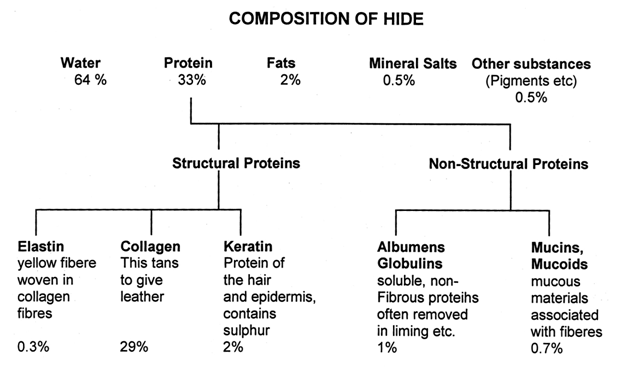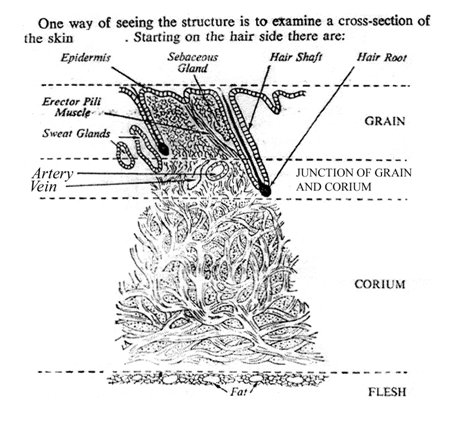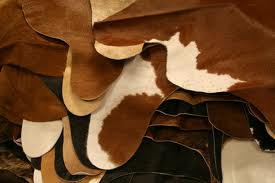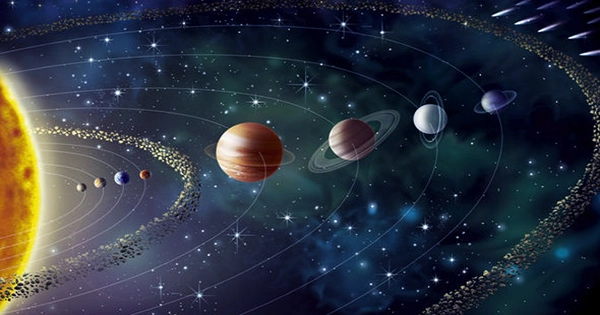HISTOLOGICAL STRUCTURE OF COWHIDE:
Cowhide is the natural, unbleached skin and hair of a cow. It retains the original coloring of the animal. Cowhides are a natural product/by-product of the food industry from cattle. Cowhide can also be processed into a leather, which can be used to make such things as shoes, wallets, leather jackets, and belts.Fresh hides or skins consist of water, protein, fatty materials and some mineral salts. Of these, the most important for leather making is the protein. This protein may consist of many types. The important ones are Collagen, which on tanning, gives leather and keratin, which is the chief constituent of hair, wool, horn and the epidermal structures.
The approximate composition of a freshly flayed hide is as follows:


- The hairs embedded in hides/skins, each in a sheath of epidermis known as the hair follicle and each with a hair root at its end, fed by a tiny blood vessel. Chemically the hairs consist of the protein keratin at the form of cells, dead and resistant at the tip and living and easily destroyed at the root.
- The epidermis, a protective, hard-wearing layer of keratinous cells. Those on the outside are dead on drying and shrinking, fall off the skin as scurf or dandruff. On the under-side, next to the skin proper, they consist of soft, jelly-like living cells, which have little resistance and are readily attacked by bacterial action or enzymes as occurs with stale skins or in enzyme unhairing. They are easily disintegrated by alkalis, such as caustic soda lime and especially sodium sulphide or hydrosulphide.This action is the basis of the common unhairing process in the limeyard,when and the lime Sulphide destroy the hair roots and soft underside of
the epidermis. - The sweat glands (Sudoriferous glands), which are also lined with epidermis and discharge sweat from the skin through the pores in the grain surface.
- The sebaceous glands, which are located at the side of the hair follicles
and discharge into them an oily waxy substance, which protects the hair. The gland is operated by muscles, the erector pili, which cause the hair to
stand upright; this happens when the animal is cold or frightened and also
causes a pebble-like appearance on tile skin known as “goose flesh” or
“goose pimples”.
The skin proper or corium consisting of a network of Collagen fibers, very infinitely woven and joined together. In the grain layer these fibers become very thin and tightly oven and so interlaced that there are no loose ends on the surface beneath the epidermis. Thus, when the epidermis is carefully removed, a smooth layer is revealed sometimes known as the hyaline layer which gives the characteristic rain surface of leather.
Towards the centre of tile corium the fibers are coarser and stronger and tile predominant angle at which they are woven can indicate the properties of the resultant leather.
If the fibers are more upright and tightly woven, one expects of firm hard leather with little stretch, whereas if they are more horizontal and loosely-woven, one expects soft, stretchier leather. The corium is generally the part of the skin. The flesh side of the corium i.e. next to the “meat”, where the fibers have a more horizontal angle of weave and fatty (or adipose) tissue may also be present.
Grain layer of cow hides at neck:
a. Epidermis
b. Cellular tissue
c. Erector pili muscle
d. Sebaceous gland
e. Root sheath containing the
hair root
f. Hair shaft within the follicle
g. Sweat gland
h. Duet of the sweat gland
i. Blood vessel
The cow hides have the greater ratio of grain to corium and smaller fibers, which are less compactly woven.
Grain of wet-salted cow hide showing the great number of cells.
















